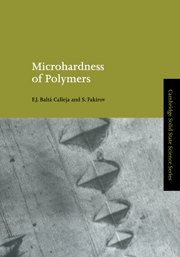Book contents
- Frontmatter
- Contents
- Preface
- Chapter 1 Introduction
- Chapter 2 Microhardness determination in polymeric materials
- Chapter 3 Microhardness of glassy polymers
- Chapter 4 Microhardness of crystalline polymers
- Chapter 5 Microhardness of polymer blends, copolymers and composites
- Chapter 6 Microhardness of polymers under strain
- Chapter 7 Application of microhardness techniques to the characterization of polymer materials
- Author Index
- Subject Index
Chapter 5 - Microhardness of polymer blends, copolymers and composites
Published online by Cambridge University Press: 23 October 2009
- Frontmatter
- Contents
- Preface
- Chapter 1 Introduction
- Chapter 2 Microhardness determination in polymeric materials
- Chapter 3 Microhardness of glassy polymers
- Chapter 4 Microhardness of crystalline polymers
- Chapter 5 Microhardness of polymer blends, copolymers and composites
- Chapter 6 Microhardness of polymers under strain
- Chapter 7 Application of microhardness techniques to the characterization of polymer materials
- Author Index
- Subject Index
Summary
Blends of polyolefins
Model predictions in PE blends
The interest in multicomponent materials, in the past, has led to many attempts to relate their mechanical behaviour to that of the constituent phases (Hull, 1981). Several theoretical developments have concentrated on the study of the elastic moduli of two-component systems (Arridge, 1975; Peterlin, 1973). Specifically, the application of composite theories to relationships between elastic modulus and microstructure applies for semicrystalline polymers exhibiting distinct crystalline and amorphous phases (Andrews, 1974). Furthermore, as discussed in Chapter 4, the elastic modulus has been shown to be correlated to microhardness for lamellar PE. In addition, H has been shown to be a property that describes a semicrystalline polymer as a composite material consisting of stiff (crystals) and soft, compliant elements. Application of this concept to lamellar PE involves, however, certain difficulties. This material has a microstructure that requires specific methods of analysis involving the calculation of the volume fraction of crystallized material, crystal shape and dimensions, etc. (Baltá Calleja et al., 1981).
For this reason, it is of interest to investigate the H of a model system composed of varying mixtures of two types of PE with well-differentiated microhardness values in such a way that the experimental microhardness data derived can be compared with predictions for the various component arrangements. In addition, the measurement of H of these blends at high temperature can provide direct information on the microhardness of the disordered phase.
- Type
- Chapter
- Information
- Microhardness of Polymers , pp. 127 - 175Publisher: Cambridge University PressPrint publication year: 2000

